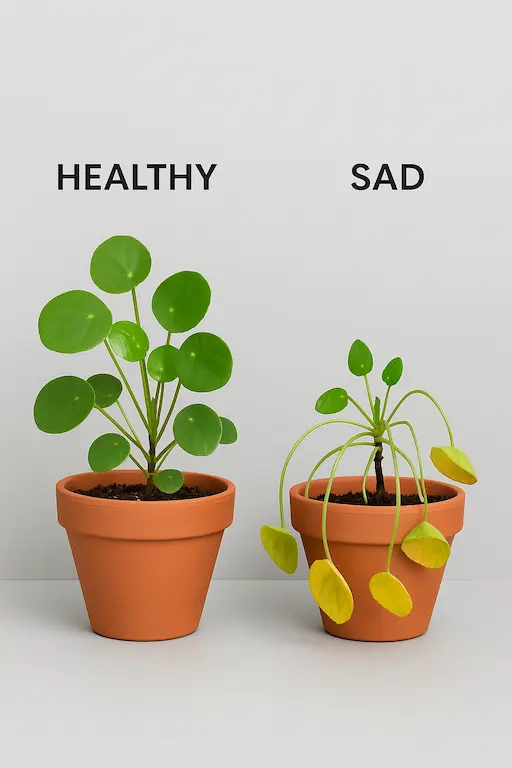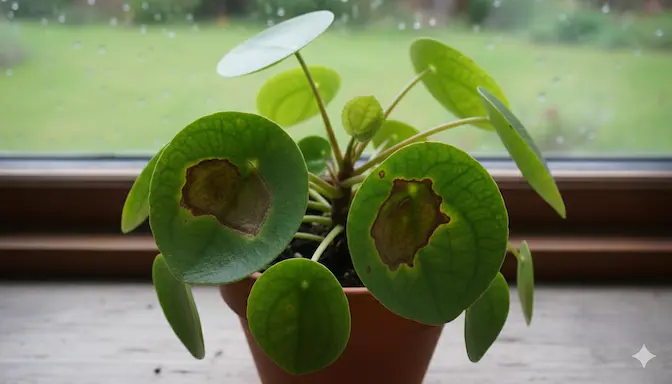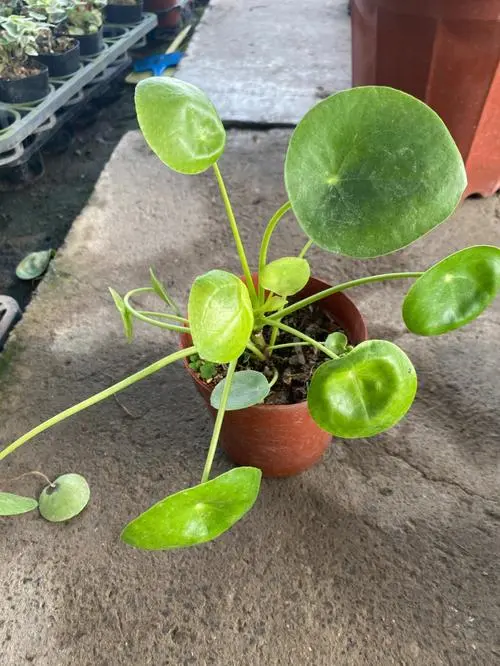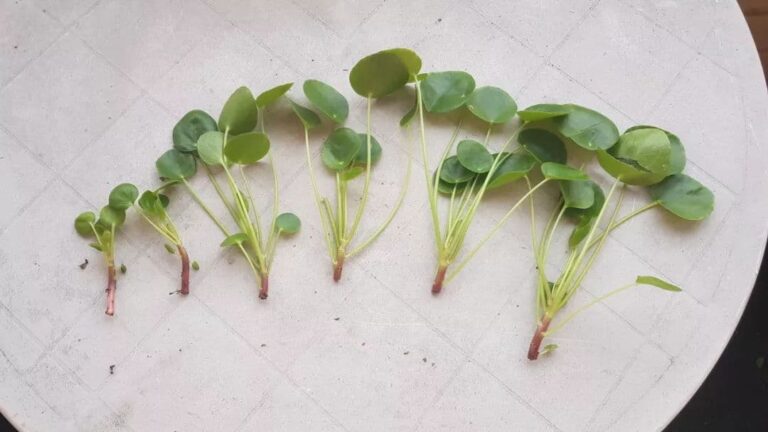How to Save a Dying Chinese Money Plant: A Step-by-Step Rescue Guide
It’s heartbreaking to see your beloved Chinese Money Plant (pancake plant), once a symbol of good fortune, looking sad and sickly. Drooping leaves, yellowing, or leaf drop can feel like a personal failure. But before you mourn your green friend, know this: more often than not, a dying Pilea can be brought back to life.
This comprehensive guide will act as your plant’s ER. We’ll walk you through how to diagnose the problem and provide the urgent care your Pilea needs to recover its lush, pancake-shaped glory.
Is Your Chinese Money Plant Dying? Key Signs to Look For
First, know that it’s normal for older, lower leaves to occasionally yellow and fall off as part of the plant’s natural growth process. The warning signs of a dying plant are more severe and widespread:
- Rapid, Widespread Yellowing: Multiple leaves, especially new growth, turning yellow at once.
- Mushy Leaves and Stem: Leaves feel soft and limp, and the main stem may become soft, wrinkled, or even blackened.
- Mass Leaf Drop: The plant is dropping a significant number of leaves, not just one or two.
- Crispy, Brown Leaves: Leaves are dry, brittle, and may be curling at the edges.
- Foul Odor: A smell of decay coming from the soil indicates root rot.
- No New Growth: The plant has completely stopped producing new leaves or pups for an extended period.
If you’re seeing these signs, your plant is crying out for help. The next step is to figure out why.
Step 1: Diagnose the Problem – What Is Your Plant Trying to Tell You?
The first rule of plant rescue is to correctly identify the issue. Wrong treatment can do more harm than good. Here’s a quick diagnosis chart based on the symptoms:
| Symptom | Likely Cause | Primary Suspect |
|---|---|---|
| Yellowing, mushy leaves, wilting, soft stem, soil is wet | Overwatering / Root Rot | ✅ |
| Crispy, brown edges, drooping, dry, crispy leaves, soil is bone dry | Underwatering | ✅ |
| Leggy growth, small leaves, leaves turning pale green or yellow | Insufficient Light | |
| Brown, crispy patches on leaves, especially where sun hits | Sunburn (Too Much Direct Sun) | |
| Generalized drooping, loss of turgor (firmness) | Temperature Shock or Pest Stress |
For most struggling Pileas, the culprit is usually overwatering and root rot. This guide will focus heavily on that rescue process, as it’s the most critical.
Step 2: The Emergency Rescue Plan for Root Rot (The Most Common Killer)
If your plant shows signs of overwatering, you need to act fast.
You’ll Need:
- Clean, sharp scissors or pruning shears
- A new pot with excellent drainage holes (terracotta is ideal)
- Fresh, well-draining potting mix (a mix for succulents or cacti works well, or add perlite to regular soil)
- A fungicide (optional, like hydrogen peroxide solution)
The Process:
- Remove the Plant: Gently tap the pot and slide the plant out. Be careful not to yank it.
- Inspect the Roots: This is the most important step. Healthy roots are white and firm. Rotten roots are brown, black, mushy, and will often fall apart to the touch. They may have a foul smell.
- Prune the Damage: Using your sterilized scissors, cut away ALL rotten roots and any mushy, dying leaves or stems. Be ruthless. Any rot left behind will spread. This is a surgery to save the plant’s life.
- Disinfect (Optional): Dip the remaining healthy roots in a diluted hydrogen peroxide solution (1 part 3% HP to 3 parts water) to kill any lingering fungal spores.
- Repot: Place a layer of fresh, dry soil in the new pot. Position your Pilea in the center and fill in around the roots with more soil. Gently firm it down.
- The First Water: Do not water immediately! This is crucial. The roots are wounded and need time to callous. Wait for 4-7 days before giving it a modest drink. This helps prevent re-infection.
Step 3: Post-Op Care – The Road to Recovery
Your plant is now in recovery mode. It will be weak and needs a stable, ideal environment to put its energy into growing new roots.
- Watering: Going forward, only water when the top 1-2 inches of soil are completely dry. Stick your finger in the soil to check. When you do water, water thoroughly until it runs out the drainage holes, then empty the saucer.
- “How often should I water?” is the most common question, but there’s no one-size-fits-all schedule. The right frequency depends on your home’s light, temperature, and humidity. For a detailed breakdown, read our dedicated Chinese Money Plant Watering Guide.
- Light: Place it in a spot with plenty of bright, indirect light. An east-facing window is perfect. Avoid harsh direct afternoon sun while it’s recovering.
- No Fertilizer! Do not fertilize a recovering plant. Its roots are too tender and fertilizer can burn them, adding more stress. Wait until you see strong new growth (usually 2-3 months).
- Patience: Don’t expect miracles overnight. It may take several weeks or even a month before you see signs of new growth. The plant is busy rebuilding its root system underground.
So, How Do You Bring a Dying Chinese Money Plant Back to Life?
Bringing your Pilea back to life boils down to three critical steps:
- Correctly diagnose the issue (see the chart above).
- Take immediate surgical action (especially for root rot).
- Provide patient and consistent aftercare in an ideal environment.
What If It Was Underwatered?
The process is much simpler!
- Give it a Soak: Place the entire pot (with drainage holes) in a sink or bucket filled with 3-4 inches of lukewarm water.
- Wait 30-45 minutes: Let the soil soak up water from the bottom until the top layer feels moist.
- Drain Thoroughly: Let all the excess water drain out completely from the pot.
- Prune: Trim away any completely crispy, dead leaves so the plant doesn’t waste energy on them.
- Resume Regular Watering: Going forward, check the soil moisture more frequently to avoid letting it get bone dry again.
FAQ: Saving a Dying Chinese Money Plant
Q: Can I propagate a dying Pilea?
A: Yes! If the stem is completely rotten, all hope is not lost. Look for any healthy leaves or offshoots (“pups”) you can salvage. You can propagate Pilea from a healthy leaf stem or pup in water or soil. Check out our guide on Chinese Money Plant Propagation for detailed instructions.
Q: How long does it take for a Pilea to recover?
A: With proper care, you should start to see new growth in 3-6 weeks. Full recovery can take a few months. Be patient.
Q: Should I mist my dying Pilea?
A: Misting does not significantly increase humidity and can promote fungal diseases on leaves, especially in a weakened plant. It’s better to use a pebble tray or a humidifier if your air is very dry.
Q: My Pilea lost all its leaves. Is it dead?
A: Not necessarily! If the stem is still green and firm, there is still hope. Follow the rescue steps above and provide ideal care. The plant may still have energy to produce new growth from the stem or base.
Conclusion: Don’t Lose Hope!
Reviving a dying plant is one of the most rewarding experiences for a plant parent. While it can be scary, Chinese Money Plants are surprisingly resilient. By acting quickly, correctly diagnosing the issue, and providing consistent aftercare, you can often bring your Pilea back from the brink.
For more details on keeping your plant healthy after its recovery, read our ultimate guide on Chinese Money Plant Care Indoors.
Did you find this guide helpful? Share your own Pilea rescue stories and questions in the comments below!






